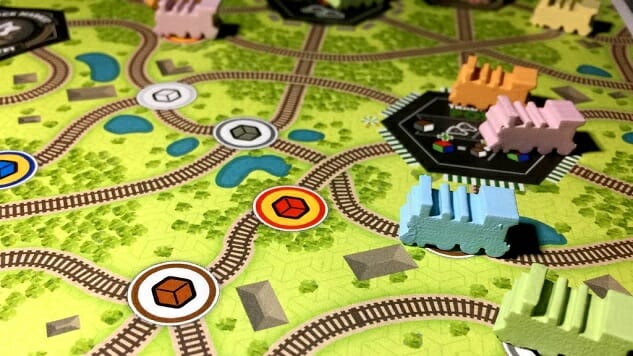The Excellent Whistle Stop Keeps the Train Game Genre Chuggin’ Along
Art courtesy of Bezier Games
The last thing we need in board games is another train game, right? It’s definitely up there on the list of most overdone board game themes, right up there with collecting wood, drawing five cards for your hand every turn, and setting games in central European cities that I’ve only heard of because they’re on the Thurn und Taxis board. And when I saw Whistle Stop at GenCon, I loved the look of the board, but was concerned the designer had packed way too many concepts into it: you’re building routes, collecting goods, gaining stock in rail companies, and managing coal resources that define your movements.
If the intro didn’t make it obvious, Whistle Stop is fantastic. It’s the train game we needed, fitting in that middle ground between the best gateway titles like Ticket to Ride and heavier titles like Martin Wallace’s Age of Steam (an economic, route-building game) or Russian Railroads (worker placement with zero randomness). Whistle Stop manages to borrow from the best train games out there, but takes just a little off the top, so that the game isn’t heavy, turns stay short, and you’re never burdened with money or other serious accounting. It’s also bursting with possibilities for each turn, so while you do have a lot of decisions to make, you’re nearly always choosing from great options. And, most important of all, it’s fun.
Whistle Stop starts with a half-formed board: There’s a frame, and three columns of the possible eight are filled with hexagonal tiles. The leftmost (“western”) column has end tiles, which award points if you get a train there and can trade in the exact three resource cubes depicted on that tile, and/or stock bonus tiles, which give you three or four points per stock certificate you’ve acquired over the course of the game. The rightmost column will have basic tiles with tracks and, usually, at least one stop where you acquire a resource. The one column near the center that’s completed has “special” tiles, including tiles where you trade in two resources to acquire a stock certificate; trading posts where you can swap resources for other colors or to gain coal or other tokens; coal yards, which I seriously hope is self-explanatory; and other types.
At the start of the game, each player places all of his/her trains on the open spots on the right/eastern edge of the board, and on the first turn those trains will begin to move on to the tiles. (It’s five trains in a two or three player game, four in a four-player, three in a five-player.) You get an allotment of two coal tokens per turn, and start the game with coal and one whistle token. You can spend four tokens per turn on actions. A coal token lets you move one train to the next stop to the west or anywhere in the same column. A whistle token lets you move one or two stops (you simply skip the intermediate one, without collecting anything), and you can go in any direction. When you move any of your trains to an empty spot on the board, you get to place a new tile on the board from your hand of three tiles, and thus can place tiles to gain specific resources you need for other actions in that turn.
-

-

-

-

-

-

-

-

-

-

-

-

-

-

-

-

-

-

-

-

-

-

-

-

-

-

-

-

-

-

-

-

-

-

-

-

-

-

-

-








































